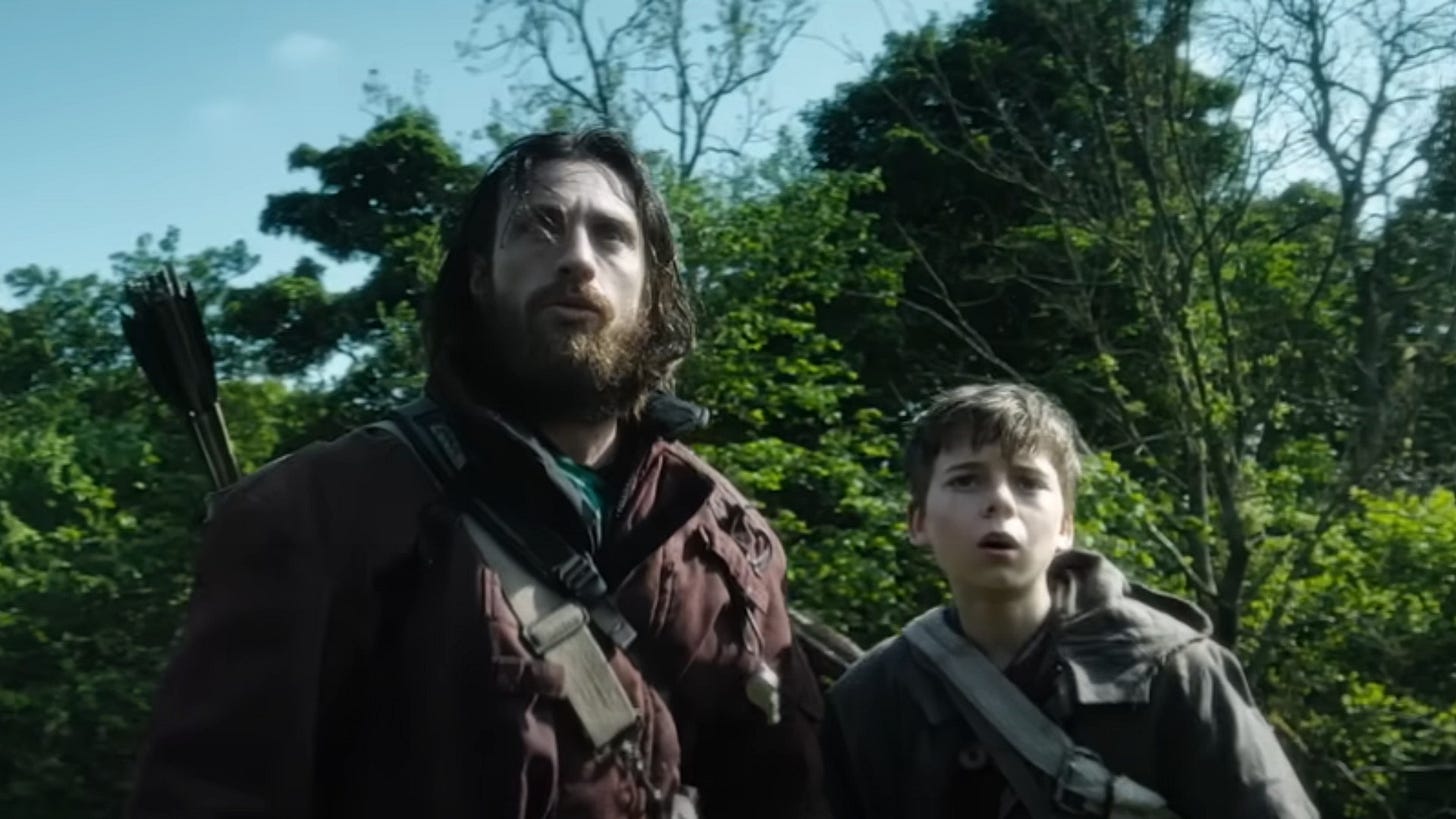Death and Transfiguration: 28 Years Later (Danny Boyle, 2025)
Boyle-hood in the age of the internet
A frequent defense of science fiction surrounds the idea that placing human drama in extreme, fantastical environments reveals fundamental truths about our existence. Few recent films are a better representation of this than Danny Boyle’s 28 Years Later, a zombie film where the zombies are largely incidental, acting as emphatic counterpoint to intimate familial dramas.
Set 28 years after the Rage Virus zombified most of the British population, the third installment of Boyle’s 28 franchise considers the evolution of a United Kingdom quarantined from the rest of the world. All over the country, populations have turned to caricature-esque British lifestyles for survival. While another group has evolved into predatory Jimmy Savile lookalikes, in the Scottish Isles, a community has reverted to medieval, folkloric society, the type we might associate with Robin Hood or Shakespeare. Within these gates, 12 year-old Spike is initiating a masculine rite of passage, venturing out into the mainland with his father for his first kill of an “infected”. At home, his mother suffers from a mysterious illness that leaves her physically and mentally incapacitated. The script, recognizably penned by Alex Garland, is a picaresque, charting Spike’s coming-of-age through his parental relations, first on the outing with his father, and then on a secret expedition to find a mysterious doctor with his mother.
One of the smarter tactics employed 28 Years Later is its placement of intimate human emotions against the illusory storybook values of genre cinema. The strongest section of the film is the opening, which thrillingly depicts Spike’s mythical coming-of-age (his first kill and near escape from an alpha zombie) only to confront him with the “real shit” (his domineering father’s infidelity). Boyle, who shot 28 Years Later on a rig containing dozens of iPhones with DP Alex Dod Mantle, displays a wild formal sensibility in outdoor zombie sequences. His contorted digital images alternate between extreme high and low angles, feature killshot slo-mo, leap into bursts of razor-fast montage, and are assaulted by an arsenal of digital effects. The gaze of the Rage Virus is depicted in a red filter, and frequently the frame seems to refract, looking somewhere between multi exposure and reality ripping open at the seams. Combined with the lore of the virus, which are used by alphas as steroids while others devolve into a frenzied madness, Boyle’s iPhone showboating resonates with a contemporary decay of conspiracy theorists, broken attention spans, and even body modification.
While Spike’s journey with his mother for a magical cure traces a similar trajectory, that what might be the onset of Rage Virus is actually a more tragically mundane illness, the returns quickly diminish. Garland’s episodic detours are increasingly tedious, riddled with masturbatory symbolism (the burden of which is primarily placed on the film’s female characters), and overelaborated to the point where they feel juvenile. A broken down tube train facilitates a risible connection between woman and zombie. The devastating climax is undercut by flashback montage and held through a sequence built off of the Latin phrase “memento mori”. While Boyle’s formal showboating occasionally offsets the film’s portentous nature, his images take on a more self-serious tone in the film’s latter half. Featuring striking long shots of characters navigating British ruins and close-up two shots where characters faces are cut off by the frame, the style is occasionally reminiscent of both Malick and late-period Von Trier. Boyle is successful at conjuring a sense of infected landscape, but the lyrical gravitas only accentuates the weaknesses of the text.
What Garland and Boyle have in 28 Years Later is a brilliant concept, using genre conventions and formal experimentation to emphasize the perils of contemporary boyhood. 28 Years Later’s identity as a coming-of-age film sits within the hallowed British tradition of working-class bildungsromans of young boys growing up in broken families (Kes, the Bill Douglas Trilogy, The Long Day Closes, Ratcatcher). Just as a quarantined United Kingdom has snapped to stereotypically British ways of life, 28 Years Later’s narrative embodies the tenderest, most lyrical lineage of its country’s national cinema. Boyle asks what a version of these films looks like in the present day (and also finds a relatively subtle way of injecting national allegory in the process). The answer is a grotesque netherworld of menacing, free floating iconography where the cosplay of the Spike’s relatively benign Scottish community and the perversion of the 21st-century sex pests are treated as parallel threats to the zombies’ plethora of social maladies. Identity formation isn’t just hard, but more dangerous than ever when the models are right-wing male influencers, regressive traditionalists, and assaultive “brain-rot”. Despite its inconsistent execution, 28 Years Later is incredibly moving in its broad strokes, driven by the feeling of being lost in the ruins of modernity, and the confusion of self-identification in an era of digital images.
28 Years Later is distributed by Sony Pictures and is in theaters now



Really effective review Eric! While I disagree that the film’s sentimental moments are an unnecessary indulgence of Garland’s, I think that its sense of eclecticism does work to the detriment of the film overall.
You identified the post modern sensibility to construct a film around the preconceived image of others very powerfully in the contrast between Boyle’s iconoclasm and Garland’s nostalgia-fuelled characters of the ‘Jimmy gang’. This film does feel conflicted as to whether it wants to be a cultural touchstone mirroring earlier entries or something which purposefully subverts them altogether and that to me is its greatest pitfall.